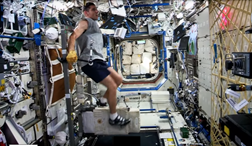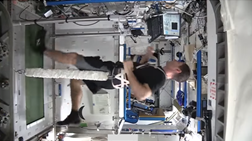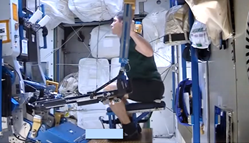MOJ
eISSN: 2576-4519


Editorial Volume 5 Issue 1
Department of Biomechanics and Sport Engineering, Gdansk University of Physical Education and Sport, Poland
Correspondence: Wlodzimierz S. Erdmann, Department of Biomechanics and Sport Engineering, Gdansk University of Physical Education and Sport, Gdansk, Poland, EU
Received: February 22, 2021 | Published: February 26, 2021
Citation: Wlodzimierz SE. Maintaining physical fitness during long-time space flights. MOJ App Bio Biomech. 2021;5(1):5-6. DOI: 10.15406/mojabb.2021.05.00149
On February 18th 2021 Mars rover Perseverance landed on Mars surface. The journey of the six-wheeled robot vehicle lasted seven months. During this time the rover travelled from the Earth to the Mars around 470 million km. There is a communication delay of 11 minutes between the two planets.
Interplanetary journeys were the human race dream for several years. The 20th century giants in space research Konstantin Tsiolkovsky (Russian scientist with Polish descent, 1857-1935) and Werner von Braun (German scientist who after the 2nd World War was taken into the United States, 1912-1977) gave the idea on interplanetary journeys. Tsiolkovsky said: “The Earth is a cradle of humanity, but a man should not be in a cradle for the whole life”. After around 100 years more and more people are dreaming about space journeys. Larry Young, in 1980s director of Man Vehicle Laboratory in the Massachusetts Institute of Technology, Cambridge, Ma. had his license plate with a label “2MARS”.1
In 1883 Tsiolkovsky wrote a paper “Free Space” where he presented his thoughts about weightlessness state that would influence humans during a space flight.2 In order to produce artificial gravity Tsiolkovsky and von Braun gave an idea of very big circular construction which would move around an axis of rotation with a frequency of one turn in one minute. Astronauts would live (work and sleep) there. A centrifugal force would act as an artificial gravitation force. Peter Diamandis (from USA) had an idea to introduce a carousel like device where astronauts would be situated with their heads in a place of axis of rotation (an acceleration equals zero there) and the rest of the body would be subjected to small centrifugal force. Diamandis’ device would be applied during a sleeping time.1
There are different types of flights in weightlessness: a) sub-orbital flights (over 100 km above the Earth’s surface; b) orbital flights (around the Earth); c) flights to the Earth’s Moon; d) inter-planetary flights. In order to be acquainted to the state of weightlessness future astronauts: a) train during water immersion where gravity force is equaled with buoyancy force; b) fly during parabolic plane flights where centrifugal force equals gravity force for about 25-30 s; c) can train in an indoor vertical wind (aerodynamical) tunnel where gravity force is equalizing by stream of an air moving upward with the velocity of 300 km/h.
The feeling of gravity is when it is felt through the reaction force from the ground. The lack of that force is described as the state of weightlessness. During prolonged stay aboard a space station orbiting the Earth cosmonauts, astronauts, taikonauts are subjected to several weightlessness negative effects. The longest stay there was over one year (Valeriy Polyakov, 438 days). The same problem would be aboard a spaceship travelling to Mars. While on Mars astronauts would be subjected to the gravity about one third of that on Earth. In order to get to the Mars, stay there, waiting for proper configuration of two planets (Earth and Mars), and travelling back to Earth, it will take almost two years.
Several astronauts have problems to adjust to the state of weightlessness. One of the descriptions of this gave astronaut Mike Massimino from NASA.3 Howell presented these negative effects as follows4: a) bones and muscles (including heart muscle) weaken; bones not loaded properly do not keep calcium, their density lowers and astronauts are more susceptible to breaking them and muscles that do not overcome loads lose their mass, lose their strength and endurance; b) astronauts experience problems with control of their bodies; stimuli that acts on their proprioceptive and vision sensors are quite different in space; c) lack of loads that usually exist on Earth and lower workload are the reason blood of astronauts has less red cells; d) clean air within the space station, lack of microbes is a reason that there are less white cells within the blood.
In order to fight negative effects of long-term space journeys there is a program of maintaining good level of fitness. It begins on Earth where astronauts have strength sessions four times a week (Figure 1).5

Figure 1 An astronaut during muscle strength training on Earth (courtesy: NASA, 2013).5
At the beginning of space era, cosmonauts took with them small devices resembling a spring or other elastic material in order to make some exercises with their hands. Later on special athletic devices – movable (requisites, equipment) and immovable (appliances, stands) for executing exercises were installed onboard the space stations, including the International Space Station. There were slippery surfaces where astronauts ran wearing socks with their bodies pulling down with the help of personalized harness and elastic buckles. There were also rowing machines. Modern fitness devices at the International Space Station are: a) stationary bicycle (Figure 2), b) treadmills (Figure 3); c) resistance stand ARED (Advanced Resistive Exercise Device) where a bar or a lever is lifted and its movement is opposed by special resistance mechanism, i.e. pneumatic/vacuum cylinders which can create a resistance up to around 2700 N (Figure 4). In all these examples a biomechanical approach is utilized, namely: overcoming of inertia, friction, elasticity, resistance of mechanisms, setting of velocity of a treadmill. The machines are isolated from the Station walls due to the vibrations. Devices are connected to the computer that allows astronauts to track their performance. Collected data are also sent directly to Earth for analysis.6,7 Biomechanical elaborations on space flights presented among others Cavanagh8 and Erdmann.9

Figure 2 Stationary bicycle (courtesy: NASA, 2014).6

Figure 3 Treadmill with harness and springs pulling astronaut towards the surface of the treadmill. In the weightlessness directions up and down, and to the sides are conventional (courtesy: NASA, 2014).6

Figure 4 ARED resistance stand for training of several muscle groups (courtesy: NASA, 2014).6
Exercises are important part of the daily routine. On average astronauts exercise two hours per day, including changes of garments and washing their bodies. Exercises help astronauts to adjust to the life on Earth after spending on ISS several weeks and months.
During long journey to the Mars and also on the surface of that planet when people will be living there, special space gym will be needed, i.e. special room with several fitness stands. On Mars exploration wrote especially Zubrin, founder of Mars Society (in 1998).10

©2021 Wlodzimierz. This is an open access article distributed under the terms of the, which permits unrestricted use, distribution, and build upon your work non-commercially.